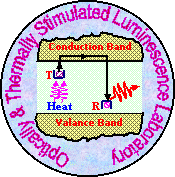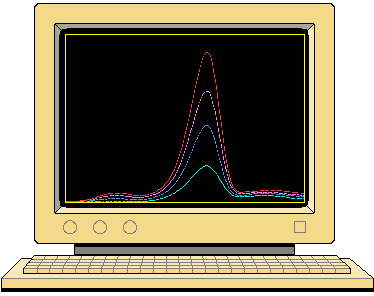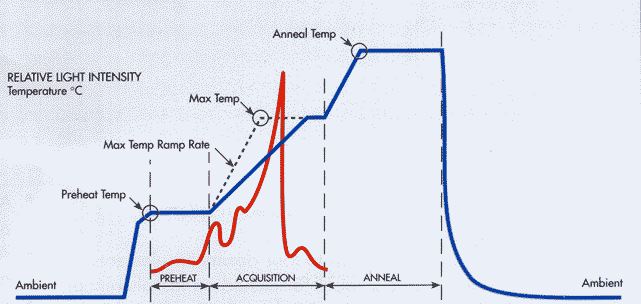 |
|
 |
|
The most commonly used TL phosphors are lithium fluoride, calcium fluoride, lithium borate and calcium sulphate. They are usually manufactured in the form of chips (3.2 mm square by 0.9 mm thick), pellets, small rods or powder which must be encapsulated for irradiation. Lithium fluoride exhibits suitable characteristics and is commonly used in dosimetry for radiotherapy. Only a small part of the energy deposited as absorbed dose in a TL phosphor is emitted as light when the phosphor is heated, e.g. 0.4% in lithium fluoride. Therefore, TLDs must be used under reproducible conditions to obtain consistent results. Thermoluminescence dosimetry requires high precision calibration of the TLD system (TL dosimeters and TLD reader) including determination of several correction factors which account for dose response dependence, radiation type and energy dependence, loss of latent TL signal in time and the TLD readerís drift. Accuracy of the TLD method within 1.5-2% can be achieved with care. Thermoluminescent phosphors contain luminescence centres which emit light when the electrons and holes are permitted to recombine in such a centre. During irradiation, ionization events elevate electrons into the conduction band where they can migrate to electron traps (the holes migrate to hole traps, respectively). Electrons (holes) can stay in their traps for extended periods of time at room temperature. When the phosphor is heated, electrons (holes) can be released from their traps and migrate to luminescence centres where they can recombine with each other. The recombination is accompanied by the emission of light photons. TLD Dosimeters {Lithium Fluoride (TLD-100, TLD-600, TLD-700), Calcium Fluoride Dysprosium (TLD-200), Aluminum Oxide (TLD-500) and Calcium Sulfate Dysprosium (TLD-900), Calcium Fluoride Manganese (TLD-400)}are one of the most advanced application of Themoluminescent Detectors. Thermoluminescence Detectors (TLDs) are based on the emission of Thermoluminscence (TL) on heating of previously exposed crystalline materials. The intensity of the emitted TL is a function of the dose deposited in the material, and can therefore be used for dosimetry. The production of TL in dosimetric materials is a complex, multistage process involving the transfer of charge and energy between different defect states within the crystal. The final measured TL intensity is the net result of the reaction between photons or nuclear particles of the irradiation field, the type, number and distribution of the defects present within the crystal at the time of irradiation and heating, the nature of the irradiated crystal and on other factors such as the irradiation rate, temperature, and energy of the absorbed particles. Thermoluminescent dosimeters (TLDs) offer precise response to a variety of radiation types including beta, gamma, neutron and X-ray radiation. TLD badges also offer the advantage of longer wear periods than film badges due to their resistance to environmental factors such as heat and humidity. All TLD processing is fully automated, reducing the chance of human error and misidentification. Proprietary algorithms provide for exceptionally accurate dosimetry. Reports are computer generated. Exposure histories are automatically updated in each report. Our TLD 100 and 760 badges come pre-loaded. No tedious badge loading at change out is required. The simplest model of the TL process involves a single state for holes and a single state for electrons. Electrons trapped at trap sites of the crystal are thermally elevated into the conduction band during the heating process. Once in the conduction band, the electrons are captured by holes trapped in luminescence centers, with emission of photons. Several materials were found to be suitable for TLD dosimetry. The most common application of TLD dosimeters is in personnel dosimetry. Specifications (materials, geometry, shielding) of TLD dosimeters can be found in the paragraph on TLD Badges. The most common application of TLDs is in gamma ray and X-ray dosimetry. However, they can also be used for neutron dosimetry and for the dosimetry of heavy ion beams. Irradiators (for calibration purposes) and readers
are needed for the operation of TL dosimetry systems. The TLD Read Process
follows strict guidelines.
Response Functions of TLD Dosimeters to photons of various energies can be calculated by the microcomputer program PHOTCOEF . After exposure, the TLDs of dosimeters are subjected to a Read Process, after which a Dose Conversion Algorithm is used to convert the outputs of the TLDs to total dose.  |